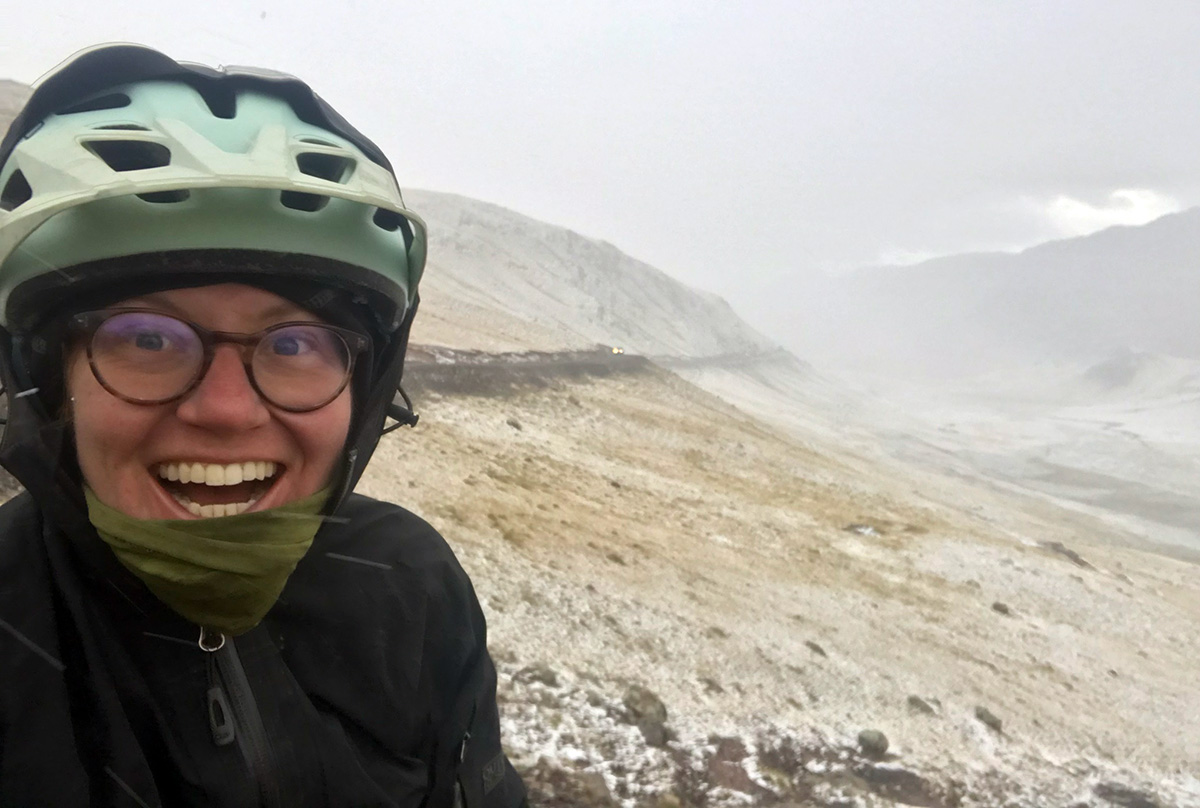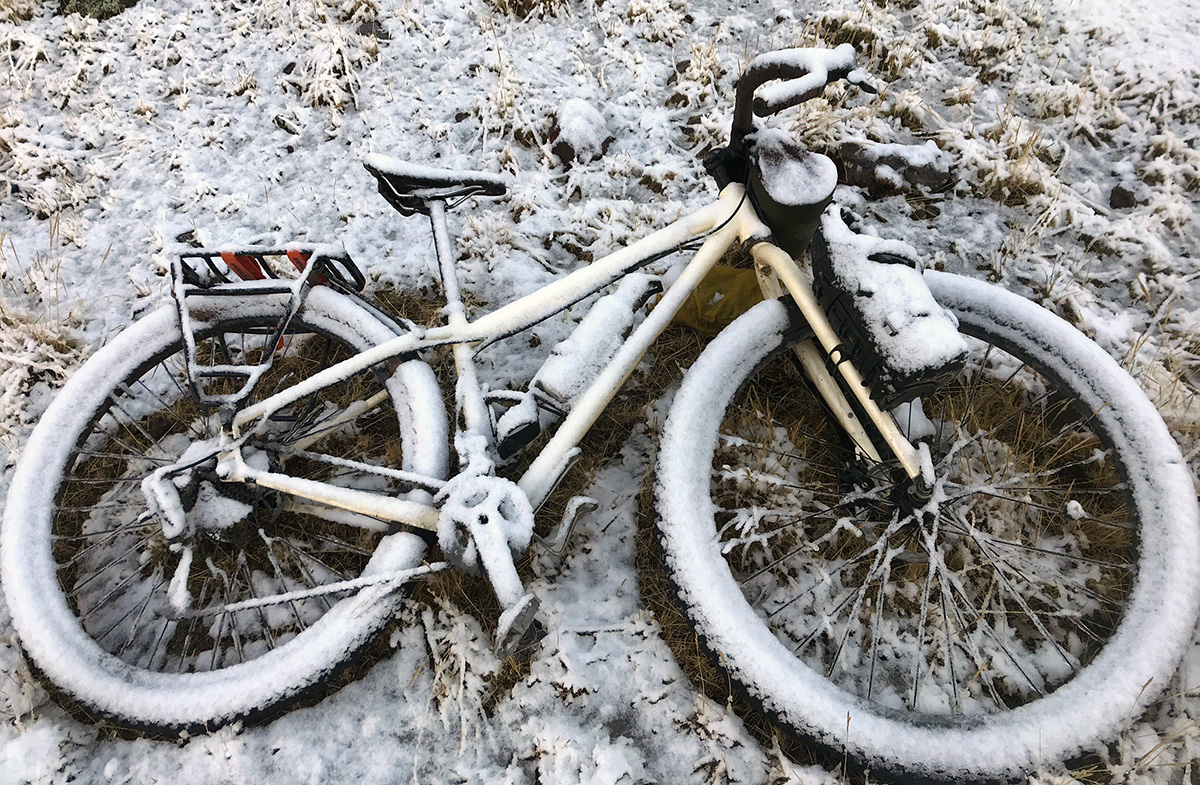Rain and Snow? Just Go.
Whenever I cancel a trip due to weather reports, it seems like whatever hellacious storm that is sure to come somehow misses me and I’m stuck inside with all the chores I was putting off. Then the benign, overcast sky taunts me with pokes of occasional sun. With obvious exceptions, much of the time it’s better to just pack your rain gear and go for it.
There’s a not-so-fine line between being prepared to accept a bit of discomfort and being foolhardy. Before any tour, check the weather forecast and look up the average low temperatures. You don’t want to put yourself in a life-threatening situation, but you do want to be prepared because bad weather can find you on top of high mountain passes in summer, or in fickle foothills in shoulder seasons. Winter can also be a rewarding and peaceful time to explore on roads or trails.
Most regular touring gear will work fine in the cold with a few additions and adjustments, but there are some additional steps you can take to stay warmer and safer in cold, rain, snow, or all three.
Before You Go
Like with any tour, make sure you are familiar with your gear. The stakes are a little higher in inclement weather, so if you haven’t yet, set up and take down your tent several times and boil water on your stove. You don’t want to be fussing around with poles and fuel attachments in freezing rain — you want to be an efficient machine.
What to Wear
You want to keep your core warm while minimizing sweat, which can be a tricky balance if you’re going up and down a lot of hills. At one point, you’ll be too hot, and at another point, you’ll be too cold. Just try to keep the pendulum from swinging too far in either direction and remember you’re not Goldilocks.
You want all of your layers to insulate but also ventilate so your sweat can evaporate. Synthetic quick-drying material and wool are both good options and can insulate when wet. Wool can air out and rid itself of some stink, whereas synthetic layers are prone to some bad-smelling juju for a bit longer. Avoid cotton. It does not dry quickly and will make you even colder when wet. My college friends and I had a saying: “cotton kills.”
A regular packing list plus a few items should suffice for mild winter cycling or unexpected bad weather: base layer, middle layer, puffy jacket, rain jacket, rain pants, leg warmers, or leggings. If it’s especially cold, you’ll probably want an insulated waterproof jacket and pants, though you’ll still want some ventilation. You might want a face mask to protect your cheeks, nose, and chin, which are vulnerable to frostbite.
Wear thick wool socks to keep your toes warm while riding, and pack wool socks and long thermals just for sleeping in a waterproof stuff sack. If the forecast is nasty and your feet get really cold like mine do, you might want to ride in winter boots or rain boots instead of clip-in bike shoes. If you decide to go with cycling shoes or tennis shoes, you can put plastic bread bags between your socks and shoes. The longer, narrow shape fits over feet nicely! Alternatively, or additionally, consider wearing shoe covers. They come in a variety of materials from thick neoprene to thin windbreaker material.

Your gloves should be waterproof and windproof. For the head and ears, I prefer a wool buff over a hat because they keep my forehead and ears warm while letting some heat escape from the top of my head, preventing overheating or copious sweat. Buffs tend to be longer than I need them, so I cut off a quarter, sew the seam, and use the small part as an ear warmer and the longer part for my neck. A synthetic or satin bandana can be added or removed without taking off a helmet, and can be commonly found at thrift stores! Your neck layer can be put over your nose and mouth to warm the air you breathe, preventing some of the burning irritation in your throat and lungs caused by cold weather.
While Riding
Take short breaks so that your body temperature doesn’t cool down too much. If you need to take a longer break, choose a sunny spot where you can go uphill afterward. If you have a really long descent, it’s worth stopping at the top to layer up. Think about where all your layers are while you’re riding uphill, so you can be efficient and not left shivering while looking for your leg warmers. Keep an eye out for parts of the road that may be icy in the shade, even while the rest of the road is dry. Take it slow to navigate safely, and be prepared that a route may take you twice as long in the winter as it does in the summer.
Setting Up Camp
Stop to set up camp BEFORE you are dangerously cold and your fingers have stopped working. Most of the time, getting into dry and warm clothes immediately is best. Having a wet layer against your skin and close to your core can bring your temperature down precipitously, so get your wet sports bra off FIRST! Put on dry clothes that you also plan to sleep in, and the rest of your layers on top of those. Then you can set up your shelter more calmly, and maybe put some water on to boil in the meantime.
The exception to this is when it’s pouring down rain and you’re already soaked. You’re already about as wet as you’re going to get, so set up your tent first. Once you’ve got your little shelter up, you can throw all your gear inside and get situated. Hang a strong utility cord (often called paracord) inside your tent. I leave mine there so I always have a miniature clothesline to dry things out. Unfurl your sleeping bag and pad as soon as you can, and let them start to fluff out. The air between the particles is what keeps you warm, so you want to take full advantage!
Stove and Fuel
Both white gas and propane burn well in the cold. Alcohol and butane can be a little more problematic, and you might need to warm the canisters in your hands or pockets before lighting. Make sure your alcohol fuel is at least 90 percent pure or higher. Bring plenty of fuel, because water takes longer to boil in freezing temperatures. Bring an extra lighter or three, and store the extras in plastic bags deep in your drybag. If you’re cycling through a region with plenty of wood, a campfire is cozy and warm but check local regulations first.
If your vestibule is large enough and you feel safe doing so, you can cook and boil water there. This can help warm up your tent a bit more, but it can also be very dangerous, so take precautions or cook elsewhere. Speaking from experience, if you are cooking in your vestibule, DO NOT put any water in a pan with hot oil, or you will have a ball of fire that will burn a hole in your mesh, or rainfly, or worse.
Food and Water
After you’ve changed clothes and set up your tent, heat water if you haven’t yet. Pour some for yourself to drink and put some in a non-insulated metal bottle with a lid that can’t leak, like this one. Be careful not to burn yourself, melt your sleeping bag, or spill water in your sleeping bag. You can wrap wet socks or gloves around this bottle to dry them out, and then watch the steam evaporate. Rotate through your wet things until they are only damp, and then put this bottle in the bottom of your sleeping bag, or reheat it if necessary.

Eat more food than usual. Your body is burning more calories trying to stay warm. Choose foods that aren’t severely affected by the cold (honey, for example, becomes a solid brick), and try to plan simple meals that don’t require much preparation or cleanup. You’re not going to want to chop vegetables when it’s freezing. Dehydrated meals that only require boiling water are ideal. Or you can prepare foods that only need to be reheated.
Your thirst naturally decreases when you’re cold, so it’s easy to get dehydrated. If you choose to carry a Thermos, it will not only be delightful on cold days but also help you stay hydrated.
If you’re using a bladder in a backpack, your body heat will prevent freezing while you’re riding, but keep an eye on the line and the mouthpiece to make sure they don’t freeze and get blocked. It might be hard, but try to avoid alcohol when it’s really cold. Alcohol expands your blood vessels and allows more heat to leave your body. Personally, I am a southerner and I still have a nip of whiskey. But just a tiny nip!
The Big Event: Going to Sleep
When the weather is just below freezing, your body heat should keep the inside of your tent warm enough to prevent things from freezing. When the weather is far below freezing, you may have to bring water bottles and a few other things into your sleeping bag to prevent them from freezing:
- Water filter — it can crack and break if water freezes inside of it. Put it in a plastic bag so it doesn’t leak.
- Contact lens solution
- Batteries — they discharge quickly in cold weather, so put your lights in your tent and your phone in your sleeping bag
- Energy bars can freeze solid, so if you plan to eat these for breakfast, keep them near your toes (unless you’re traveling through bear country, that is).
- Your damp (not wet) clothes from the day can dry out in your sleeping bag.
- Put the clothes you plan to wear the next day in your bag or use them as a pillow if they are not too smelly yet, or you are beyond the point of caring. It’ll make it much easier to get dressed and get going in the morning.
There are a lot of rewards to be had by getting out there in the rain or cold. No matter how uncomfortable you might be at times, you’ll feel like the badass cyclist you are when you look back at that photo of your bike covered in snowflakes.


